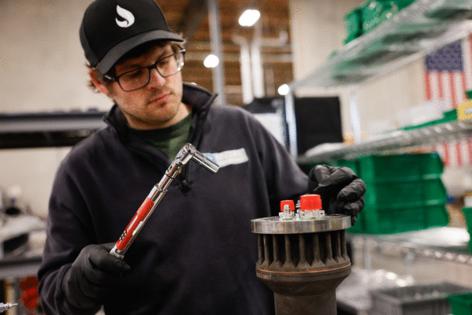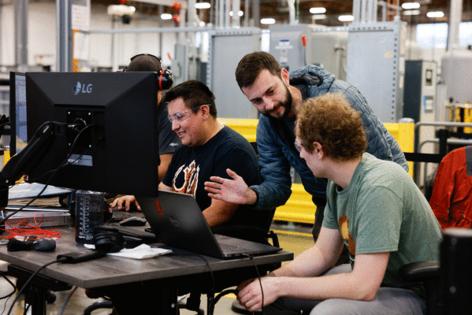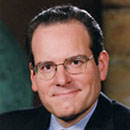How this Washington space company is building rockets to fly, and fly again
Published in Business News
The countdown to launch has begun for a small Washington state company developing something long dreamed of in the space industry.
Andy Lapsa, co-founder and CEO of Stoke Space, a standout in the state’s burgeoning space technology industry, calls it “this Holy Grail of rocketry, which is fully, rapidly reusable rockets.”
At Stoke’s newly built headquarters in Kent, engineers and technicians are assembling the giant barrel-shaped sections of a rocket and two very different engines designed to make not just the booster but the upper stage of the spacecraft reusable.
The goal is a rocket capable of launching into orbit, returning to Earth and then lifting off again almost daily.
The plan, said Tom Feldman, Stoke co-founder, is spaceflight on “an aircraftlike schedule.”
This would provide transformative cost savings and access that could open up space for commercial expansion and accelerate further innovation.
Kelly Hennig, Stoke’s chief operating officer, said the initial rocket launch from Florida’s Cape Canaveral is planned toward the end of next year, though that one will be expendable, not reused.
Reaching the Holy Grail, she said, will take about another year beyond that.
Stoke is designing and building its rocket in Kent and test firing engine prototypes at Moses Lake in Central Washington.
There, on 75 sprawling acres of sagebrush desert, tall white fuel tanks containing liquid hydrogen, oxygen or liquid natural gas rise like pillars around a set of intricately designed test facilities.
Those include a test stand for the booster-stage engine, rising above a 60-foot-deep flame trench where the first hotfire engine test is scheduled for later this month.
Nearby is a smaller engine stand, where Stoke has already been testing what engineer Sophia Yu calls an “insane engine” with a unique ring-of-fire design that will power the second stage of the rocket.
“It’s one of the coolest things I’ve ever seen,” said Yu, 27, who joined Stoke in March after 3 ½ years at Jeff Bezos’ Blue Origin rocket company, also headquartered in Kent.
At Moses Lake last year, Stoke conducted a short hop-and-hover test of a second-stage prototype, successfully demonstrating that engine.
Lapsa said leading his just over 160 employees to develop his rocket has been “an unbelievable experience.” Stoke is hiring and expects to double in size next year.
Butch and Sundance
Lapsa and Feldman met as rocket propulsion engineers at Blue Origin and left to found Stoke in fall 2019. On a tour of the new headquarters, the two were an odd-couple team.
Lapsa, 42, trim with silvering hair and a boyish face, wore a neat black T-shirt and jeans in tech startup fashion, the image of someone who has so far raised more than $185 million from venture capitalists.
Endearingly, fashion seems of zero concern to his buddy Feldman, 36, who wore his standard work uniform: faded blue denim cutoff shorts with a puffy black vest, his hair sticking out every which way from under a baseball cap.
Lapsa, who’d worked at Blue for more than a decade, said leaving to start a company on their own was “easily the hardest decision that I’ve made.”
Feldman had been at Blue just over six years. Shaping Stoke’s engineering concept, he said, “We spent the first six months working out of my basement, heads down, doing the math on, like, ‘Is this a good idea?’ Combined with, like, ‘How do you start a company and raise money?'”
At the time, he had a 3-month-old baby at home, and the two engineers had no Rolodex of financiers to call.
“We really just jumped off the cliff together,” Feldman said.
A “ring-of-fire” engine
Together, they’ve created something new.
Feldman, who says he chose to study rocket propulsion in college because it seemed “the most badass engineering thing to do,” notes that space rockets are basically giant cylindrical fuel tanks with fiery engines at their base.
Typically a large, powerful engine lifts the payload from the bounds of Earth’s gravity. Then that stage separates and a smaller second stage pushes it the rest of the way into orbit or further in space.
While early NASA space programs developed expendable rockets that were used once then fell away into the ocean, Elon Musk’s Texas-based SpaceX and Bezos’ Kent-based Blue Origin succeeded in designing first-stage rockets that could land and be reused.
More than half a century after the Apollo moon landings, the engineering ingenuity has fired up the public imagination and a new generation’s enthusiasm for space technology. SpaceX last month achieved a startling feat: “catching” its giant new Starship’s first stage between the waiting arms of the launch tower.
Musk’s not-yet-achieved goal is also to land and make reusable the Starship’s second stage.
Stoke too aims to have a reusable second stage.
That’s a difficult design problem because the second stage will burn like a meteor when it reenters the atmosphere and requires a heat shield to survive.
SpaceX plans for the second stage of Starship to “belly flop” through the atmosphere with about 18,000 tiles protecting the belly, then flip to a vertical position when near the ground.
Stoke has devised a very different, more elegant solution.
Its second-stage rocket will come down vertically. The design problem was how to fire an engine that would slow the rocket’s descent when there’s a domed heat shield in the way to protect the circular base.
The result is that Stoke’s novel design looks nothing like a standard rocket engine, which typically has a large, bell-shaped exhaust nozzle.
Instead, around the heat shield’s circular perimeter, 24 small thrusters will fire to slow the rocket’s descent in a “ring of fire.”
The heat shield is deeply integrated with the thrusters so that it’s part of the engine.
The second-stage rocket’s fuel — cryogenic hydrogen — is also used as coolant fed through intricate internal channels in the heat shield.
When the shield gets hotter, it heats the fuel in these channels, which then drives the pumps faster and automatically increases the cold fuel flow through the heat shield.
On NASA’s now-retired space shuttle and on Starship’s second stage, each of the thousands of heat shield tiles must be inspected closely for damage before reuse. But Lapsa said Stoke’s heat shield is designed to be “just as indestructible as possible.”
Its design is so robust that “even if it was shot with a 9-mm pistol” and suffered a fuel leak, “it would still work,” said Feldman.
Building the pieces of this rocket
In January last year, Stoke moved into a new 168,000-square-foot Kent headquarters, where the workforce is young and diverse.
Manufacturing engineer McKenzie Kinzbach, 28, who previously worked at SpaceX and Universal Hydrogen, said that in a field still dominated by men, she found Stoke’s culture welcoming for women.
A tour of the facility this month started at a control room that allows remote viewing and monitoring of tests at Moses Lake and future launches at Cape Canaveral.
Beyond that, in a high-ceilinged, clean factory space, engineers and technicians worked to complete rocket engines, heat shields shaped like giant satellite TV dishes 14 feet in diameter, and immense stainless steel barrel sections that will make up the body of the rocket.
The body of Stoke’s 123-foot-tall rocket has remarkably thin walls, less than a tenth of an inch thick.
The steel arrives here as flat sheet metal, which is cut with lasers and formed in-house. Some small spherical internal fuel tanks made of steel are blown up like balloons.
Stoke’s rocket will have seven large engines on the first stage, burning oxygen and liquid natural gas and each developing 100,000 pounds of thrust. Inside the chambers where the fuel combusts, the temperature rises to about 6,000 degrees Fahrenheit.
Engine parts engineered with cooling features to withstand that temperature are made from copper, inconel — a nickel-chromium alloy resistant to extreme heat — and a proprietary material Stoke has developed for components that interface with hot oxygen.
The thrust chambers, turbine housings, fuel injectors and nozzles are all manufactured using 3D printers large enough to make metal components up to 2 feet tall.
The parabolic heat shield is fabricated by welding together 198 rectangular panels, each one 3D printed with those intricate coolant channels embedded.
A test site carved out of the desert
When Katherine Cruz, Stoke’s vice president of test operations and another Blue Origin alumnus, arrived in the spring of 2021 to set up Stoke’s Moses Lake site, it was an expanse of empty desert and they had no power, internet or piped water.
She said it took “grit and a lot of passion” to build the impressive test facility.
At the entrance of the site, a “light tree” with green, amber and red lights indicates access restrictions to each test area. When a hotfire test is imminent, a red light means no one can go in.
“We’re intentionally playing with fire,” said Cruz, 33.
In June, impatient to test-fire its first-stage engine, Stoke mounted it on a stand and shot its fiery exhaust out horizontally into empty desert.
With a massive new test stand now complete, that engine can now be tested in its proper vertical orientation.
This month, engineers will hang the engine from heavy metal rings built into the top of the reinforced concrete structure and let that exhaust flow downward into a “flame diverter” stretching 60 feet below.
Stoke broke ground on this newest structure just a year ago, digging out a deep, wide trench below and at its lowest point installing the flame diverter — a tall, curving waterfall of pipes underneath where the engine will hang.
In a hotfire test, water will be pumped through those pipes and gush from holes directly under the rocket engine’s fiery plume to absorb the energy. The steam produced will rush along the 165-foot-wide, 262-foot-long gash in the desert floor.
To find out if the novel ring-of-fire concept was feasible, Stoke built a smaller stand for testing that engine first and has fired it hundreds of times since 2022.
An updated version of that engine is now being assembled in Kent and will begin testing early next year.
“The intention of this next iteration engine is to get very, very close to what we are hoping to fly,” said Cruz.
The mission and the vision
The space industry in the Pacific Northwest has swelled in recent years and spawned a host of startup companies.
The sector is anchored by Blue Origin in Kent and two major satellite projects: Amazon’s Project Kuiper in Kirkland and SpaceX’s Starlink in Redmond. Other notable companies include Aerojet Rocketdyne, now part of L3Harris, in Redmond, and BlackSky in Seattle.
Kelly Maloney, co-founder of the trade group Space Northwest, said the industry now supports 13,000 direct employees with currently about 1,500 open positions.
Stoke’s avionics manufacturing manager James Miller, 32, who worked at Blue Origin for six years and then on Project Kuiper at Amazon, said he took a cut in salary to move to Stoke 2 ½ years ago.
When he interviewed and heard the details of Stoke’s technology plan, “I said, ‘Man, I really can’t say no to this. This is too cool.’ "
Technician manager David Hilts-Hoskins, 31, grew up in Puyallup and learned his mechanical skills mostly working on boats before he joined Blue Origin. After eight years there, he joined Stoke in January.
“I love all the novelty of everything,” he said. “It’s been amazing.”
Stoke assembly manager Tyler Crews, 37, likewise learned his skills practically, not in college, “hands-on and really being curious.” He was raised in Lynnwood, his dad worked for Boeing and his whole family is excited to see what he’s working on.
CEO Lapsa said Stoke’s rockets are designed to be reused 100 times with quick turnarounds, vastly reducing the cost of access to space.
“You wouldn’t throw a 737 away at the end of every flight,” he said. “It’s silly to do the same for a rocket.”
COO Hennig said the ability of Stoke’s rocket to bring things down from orbit as well as bring things up adds more commercial possibilities.
That could facilitate asteroid mining, space junk cleanup and orbital manufacturing — where microgravity has been touted as an advantage for making some protein-based drugs, optical fibers and even artificial eye retinas.
Hennig said Stoke has also talked to the government about potentially using the rocket to deliver military cargo at high speed across the globe, though that would presumably strand the second stage far away and make it not reusable.
Beyond these far-out concepts, everyone in this new space industry seems to share a wilder vision, one straight from the rhetoric of Musk and Bezos: humans populating space and other planets in our solar system.
For outsiders, that’s just science fiction. While envisioning scientific bases on Mars makes sense — like the bases established in Antarctica — surely no one would want to live there full time, even if it were possible.
Yet Musk, with more sway than ever after aggressively backing Donald Trump in the presidential election, has successfully sold a vision of “cities on Mars.” And people in the space industry want to believe.
“I absolutely think we will have colonies and cities on Mars or the moon,” says Lapsa, politely disagreeing with a skeptical journalist. “Whether that’s in 15 years or 150 years, I don’t know, but I think we will have them.”
The first small step for man, among the many steps to that far-off future, he sees as Stoke’s idea of making access to space routine.
“I’m very excited about all of those visions,” Lapsa said. “But I think that if any of them are going to come true, you really need a healthy, vibrant, competitive economy in space.”
While Stoke still has many technical challenges ahead to reach even its initial launch, he believes rapid reusability is within grasp.
Standing on the shoulders of the Apollo generation and using advances in computing and materials, Lapsa said, “We can do things with a cost structure and a timeline that was never possible before.”
©2024 The Seattle Times. Visit seattletimes.com. Distributed by Tribune Content Agency, LLC.





















Comments